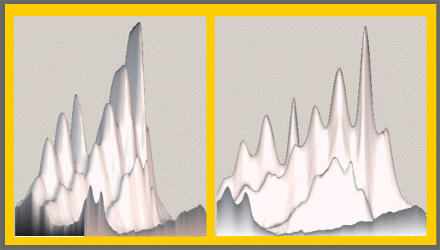Data Analysis
2D-Gel Quantification

3D-view of a 2D-gel area crowded with partially overlapping
spots of differing spot volume.
(Courtesy of Dr. Irrgang, Max-Volmer-Institut, Technische Universität Berlin, Germany)
Spot separation as well as correct quantification constitute a challenge for spot recognition algorithms and spot editing.
Precise spot quantification relies on correct spot detection and both procedures are in themselves the prerequisite for high quality gel matching and a valid spot statistics.
Although quite a range of 2D-gel evaluation software packages which can help to solve the spot detection and quantification problem had become available during recent years, none can really do a 100% error free job. Typically, spot detection error rates between 2-10% can be achieved for individual gels.The individual gel quality, the staining method applied, the software package used as well as the operator experience are the main variables determining whether spot detection errors are close to 2% or rather around 5-10%.
Spot detection errors contribute to wrong group assignments of spots during the matching process of a 2D-gel database. This is caused either by the creation of new artificial groups or by the inclusion/exclusion of spots not belonging/belonging to the respective group. These effects often lead to severe errors in the determination of the means of the affected spot groups.
While the final group assignment can still be corrected by a human operator, the correctness of spot quantification which is finally achieveable, depends alongside with the type of spot detection algorithm applied mainly on the experimental procedure used for spot staining.
Silver staining which is frequently used for the detection of low abundant protein spots, has good sensitivity (<1 ng protein/spot), however, a poor linear dynamic quantification range - approx. one order of magnitude.
Coomassie R-250 staining which is the most widely used protein staining method, has a better linear dynamic quantification range - approx. two orders of magnitude, however, much worse sensitivity (~200 ng protein/spot).
Coomassie G-250 staining, which is frequently used because of its higher sensitivity (~25 ng protein/spot) and its still sufficient compatibility with mass spectrometric procedures, offers some improvement, however, still falls short concerning detectable spot counts.
Fluorescence staining has, with the introduction of SYPRO®-Ruby become the first choice for the 2D-gel based quantification of proteins. Sypro® Ruby staining offers good sensitivity (~1 ng protein/spot) and a linear dynamic quantification range of ~3 orders of magnitude. This performance can be considered as the minimal requirement for quantitative proteome studies like target finding or mode of action studies.
A variety of other fluorescent dyes had become available during recent years. Some belong to the SYPRO®-series, some use the SYPRO®-Ruby dye in a formulation differing from the original, some are completly new developed products, like the Deep PurpleTM-stain. However, according to our experience none of the other fluorescence stains can offer a consistently improved performance. Some draw backs of alternative stains either lie in reduced sensitivity, more complicated staining procedures or inconsistent i.e. pH-depending staining sensitivity. All fluorescence stains at the high performance end add a significant amount of costs to the 2D-gel process.
Radio-Labeling combines highest sensitivity (<0.1 ng/spot) and highest linear dynamic quantification range (4-5 orders of magnitude). However, increased effort has to be applied during gel handling, staining, scanning, storing and disposal to ensure operator safety and to comply with environmental regulations.
The choice of staining method is crucial for the correctness of final spot quantification as well as for the likelihood to achieve the best possible spot detection quality the 2D-gel software package in use is capable of. Regardless of the spot detection quality initially achieved by the software, the final number of ill-detected spots needs to be significantly under 1% for each individual gel of a match set. A manual intervention of an experienced human operator at this stage significantly contributes to the quality of spot quantification, 2D-gel matching and, as a consequence, to the reliability of all results obtained by statistical 2D-gel evaluation.
SYPRO® is a registered Trademark of Molecular Probes Inc., Eugene (USA)
Deep PurpleTM is a Trademark of Amersham Biosciences AB, Uppsala (Sweden)